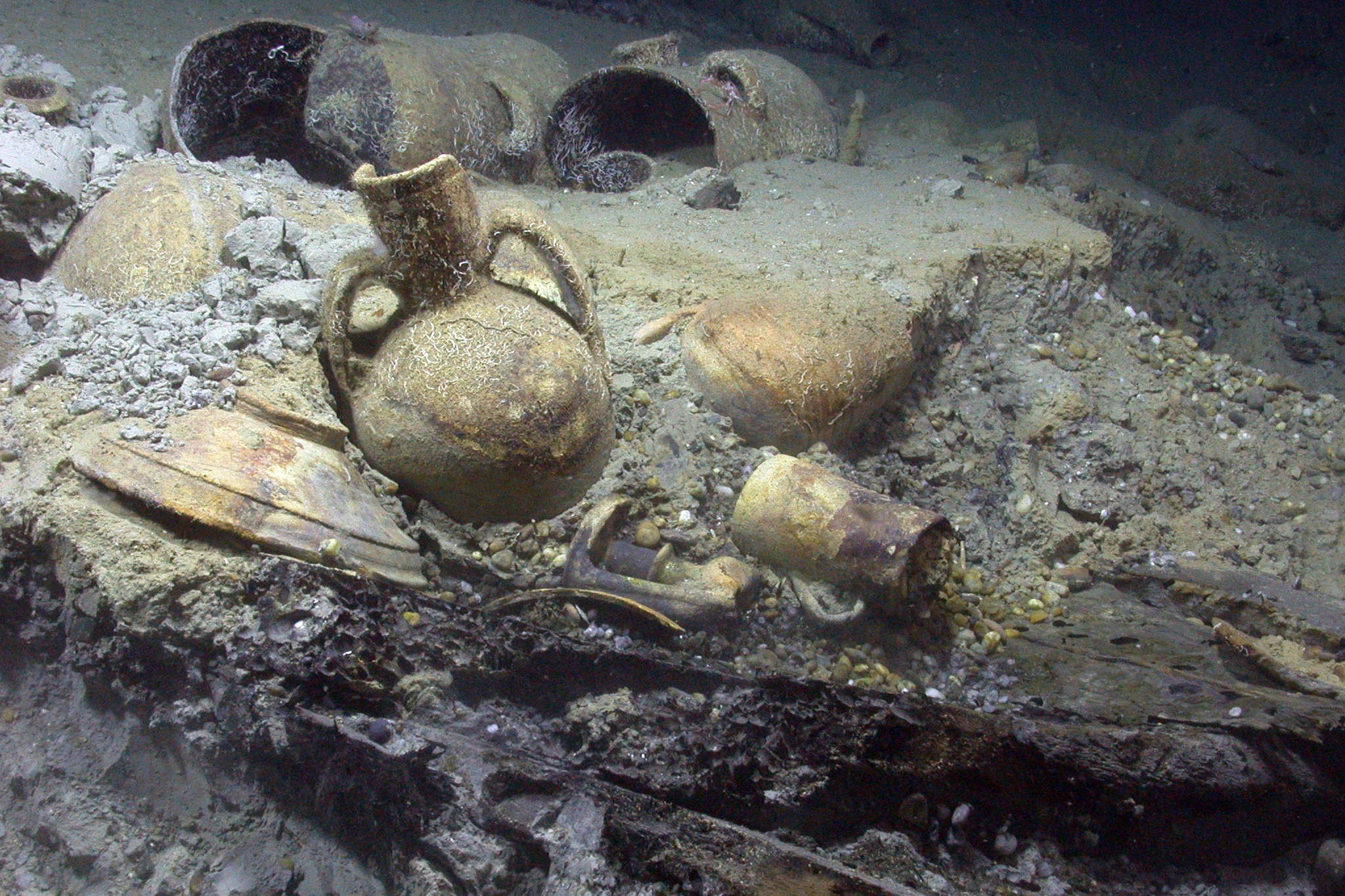A pirate shipwreck was discovered at a depth of around 2,700 feet below the Mediterranean.
The small vessel, measuring no more than around 45 feet in length, was identified in international waters midway between Morocco and Spain at the westernmost fringe of the Mediterranean.
It was found by Florida-based company Odyssey Marine Exploration (OME) in 2005, although the discovery has been kept under wraps until now. The unpublished story of the wreck appears in the summer 2024 issue of Wreckwatch magazine, which explores the real world of pirates.
The ship was once manned by Barbary corsairs, who were primarily Muslim pirates and privateers. They operated from the coast of North Africa and were a constant scourge for European ships—and coastal settlements—in the Mediterranean and beyond in the post-medieval era.
© Seascape Artifact Exhibits Inc.
The newly revealed corsair shipwreck has been linked to Algiers, now the capital of Algeria. This city was infamous in the time of the corsairs, serving as a hub for Barbary Coast piracy.
“The threat of Algiers’ corsairs was an everyday terror for the West. The shipwreck found in deep waters is a precious echo of one of the western Mediterranean’s great maritime horrors,” Greg Stemm, director of Seascape Artifact Exhibits Inc., told Newsweek.
The city attracted people from across the region—including Muslim refugees from Spain and renegade Christian converts to Islam—who dreamed of getting rich through piracy. By the end of the 16th century, the city’s population had grown to around 60,000.
“Less famous than the pirates of the Caribbean, the corsair capital of Algiers turned to piracy far earlier and was a much bigger business,” Sean Kingsley, editor-in-chief of Wreckwatch magazine, told Newsweek. “From 1525 to 1830, an entire city of 60,000 ‘rogues and renegadoes’ lived by the sword.”
“Where Blackbeard and his gang put the fear of God into single ships, the Barbary pirates terrorized entire nations,” Kingsley continued. “Like Vikings, they raided as far as southern England. Not only did they take your wealth, they enslaved anyone caught to ransom back for a heavy fee. It was an atrocity of everyday life that Western traders had to gamble with.”
The Algiers corsair shipwreck was discovered fortuitously by OME during a search for Admiral Sir Francis Wheeler’s English flagship, the 80-gun HMS Sussex, which was lost in 1694.
“In searching for a specific shipwreck in deep seas, other sites always come to light,” Kingsley said. “The Algiers corsair was a big surprise, as were Phoenician and Roman wrecks in the same seas. Down the years, Odyssey Marine discovered over 300 shipwrecks. Their study remains an ongoing process managed by Seascape Artifact Exhibits Inc.”
The scientific operations were directed from the 250-foot-long Odyssey Explorer research ship using the remotely operated vehicle Zeus, a sophisticated robot equipped with archaeology tools.
The corsair wreck’s preservation is “exceptional” and archaeologically coherent. The hull and finds remain exactly where they sank, according to Kingsley. Neither divers at this depth nor fishing trawlers have disturbed the site.
Only the lower third of the hull below the waterline survives, however. This is because in the Mediterranean “shipworms” (a type of saltwater clam) eat all organic remains above the seabed, as well as a few inches below. The site has not yet been excavated, but it is likely that the whole length of the ship—described as a “trader” vessel—down to its keel is intact below the sand.
The discovery of the corsair vessel is significant because no other wreck linked to Algiers, the corsair capital, has previously been found, according to Kingsley.
Pieces of evidence, including pottery found at the wreck site and the heavy weaponry that the vessel was equipped with, helped to determine that it was a corsair ship from Algiers.
“Two defining characteristics of pirate ships are heavy weapons and cosmopolitan cultural contents—assembled from the many prizes taken,” Kingsley said. “The wrecked corsair ship was very heavily armed with muskets, four large cannon and 10 swivel guns. When the captain ran into trouble, these antipersonnel weapons could be quickly installed for attacking crews in the rigging and on decks.”
“The bulk of the pottery is linked to kilns dug up in Martyrs’ Square in Algiers, which strongly points to the home port. The fact that the collection includes unusual glass liquor bottles made in Belgium or Germany, tea bowls from Ottoman Turkey and a European spyglass [means] the wreck looks unlike any known regular Mediterranean trader.”
Without a detailed analysis of the wooden hill, it is not yet possible to determine when the ship was constructed and how long it was in service. But the pottery and glassware on board indicate that it may have sunk around 1760.

Amsterdam Museum, 1706. Creative Commons: https://commons.wikimedia.org/wiki/File:Debarque
“Most of the pottery has exact parallels in the 18th-century ceramics excavated during rescue work in Martyrs’ Square in Algiers,” Kingsley said. “The Ottoman bowls on the wreck stopped being made in Turkey around 1755. The tightest dating comes from the glass bottles that were blown, at latest, 1740-1760. So the ship can’t postdate 1760.”
The corsair ship was probably making its way to the coast of Spain—whose ships and settlements were often the target of Barbary raids—in search of slaves to ransom when it sunk.
“The small ship almost certainly succumbed to a storm that came out of nowhere. The bold and brave corsair was punching above its weight in unforgiving seas,” Kingsley said.
Because it was so often the source of corsair raids, Algiers was constantly besieged by European forces. But eventually the threat from the city’s Barbary pirates would come to an end. After successfully fighting off several Spanish attacks—the last in 1775—the corsair capital was conquered by France in 1830.
Do you have a tip on a science story that Newsweek should be covering? Do you have a question about archaeology? Let us know via science@newsweek.com.
